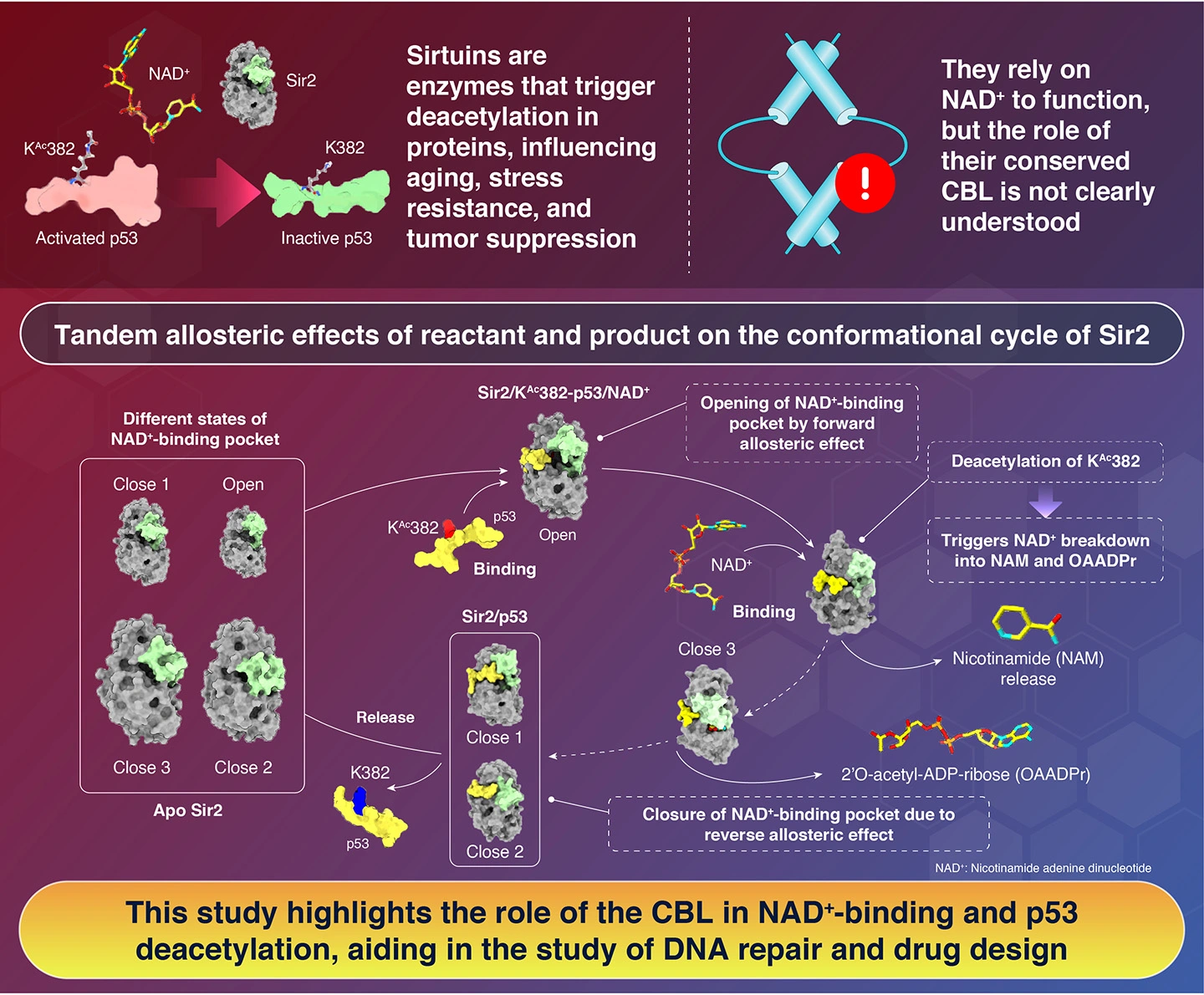Sir2, an enzyme belonging to sirtuins, has been effectively involved in the deacetylation of proteins. A tandem allosteric effect of reactant and product is responsible for the efficient deacetylation cycle of the Sir2 enzyme, reveal researchers from Science Tokyo. This finding reveals a new target for modulating Sir2, an enzyme that is essential for many biological processes, including aging, metabolic regulation, and cancer suppression. This finding could potentially lead to new therapeutic applications, including novel cancer treatments.
Understanding the Mechanisms of the Sir2 Cofactor-Binding Loop (CBL)

Bai et al. (2025) | Journal of Chemical Information and Modeling | 10.1021/acs.jcim.5c01755
Sirtuins, like SIRT1 and Sir2, are a family of enzymes that play crucial roles in a wide range of physiological and pathological processes, such as aging, stress resistance, metabolic regulation, and even cancer suppression, across almost all organisms. These enzymes trigger deacetylation, a type of post-translational modification, which is a chemical modification made to proteins after they are produced. Sir2, found in yeast, deacetylates proteins such as histones-which bind to DNA-and the tumor suppressor protein p53.
Acetylation and deacetylation of p53 are important for regulating its function. Previous studies have shown that Sir2 relies on the co-substrate nicotinamide adenine dinucleotide (NAD+) for catalyzing deacetylation reactions. Structural studies have highlighted that a flexible region within Sir2, called the co-factor binding loop (CBL), is important for NAD+ binding. However, the exact role and mechanisms of CBL in NAD+ binding and deacetylation remain unclear.
To shed light on this, a research team led by Professor Akio Kitao, along with doctoral student Zhen Bai and Assistant Professor Tran Phuoc Duy, all from the School of Life Science and Technology at Institute of Science Tokyo (Science Tokyo), Japan, uncovered the key mechanisms through which Sir2 performs protein deacetylation efficiently. "A detailed understanding of the Sir2 deacetylation process can advance our understanding of aging suppression, carbohydrate and lipid metabolism, DNA repair, and support rational drug design," explains Kitao. "Using large-scale computational simulations, we investigated the conformational changes in CBL induced by the binding of p53, revealing a 'tandem allosteric effect'-two successive allosteric steps acting in concert." Their findings were published online in the Journal of Chemical Information and Modeling on October 13, 2025.
To investigate the deacetylation mechanism of Sir2, the researchers employed molecular dynamics (MD) simulations in combination with parallel cascade selection MD (PaCS-MD). They simulated three states of Sir2: a form bound to acetylated p53 (just before NAD+ binding), a form bound to nonacetylated p53 (just after deacetylation), and the apo state (before any substrate binding).
The simulations revealed key mechanisms that enable efficient deacetylation. First, in its apo state, Sir2 exists in a closed form, which allows only weak NAD+ binding. When an acetylated protein substrate like p53 binds, an allosteric change in CBL occurs, transforming Sir2 into an open state that promotes NAD+ entry and tighter binding, subsequently leading to deacetylation. This deacetylation leads to the breakdown of NAD+ into nicotinamide and 2′-O-acetyl-ADP-ribose, both of which are quickly released. After deacetylation, a reverse allosteric effect drives the efficient release of the deacetylated protein, resetting Sir2 for the next reaction cycle. Thus, the tandem allosteric effects of the reactant (acetylated p53) and the product (deacetylated p53) accelerate the entire deacetylation process.
Moreover, the researchers demonstrated that the CBL region involved in the tandem allosteric effect is present among the sirtuins of many species, including humans. "This suggests that the tandem allosteric mechanism is a shared, evolutionarily conserved strategy among sirtuins," notes Kitao.
This study has potential implications for drug development. "Our study introduces a potential new approach for cancer therapy, targeting NAD+ binding mechanisms in sirtuins," adds Kitao. "Moreover, the PaCS-MD technique employed in this study holds promise for studying other biological systems with similar mechanisms."
Overall, this study enhances our understanding of the crucial sirtuin deacetylation mechanism, paving the way for new therapeutic strategies for aging-related and metabolic diseases.
Reference
- Authors:
- Zhen Bai1, Duy Phuoc Tran1, and Akio Kitao1,*
*Corresponding author
- Title:
- Tandem Allosteric Effects of Reactant and Product that Promote Deacetylation Cycles in Sir2
- Journal:
- Journal of Chemical Information and Modeling
- Affiliations:
- 1School of Life Science and Technology, Institute of Science Tokyo, Japan






